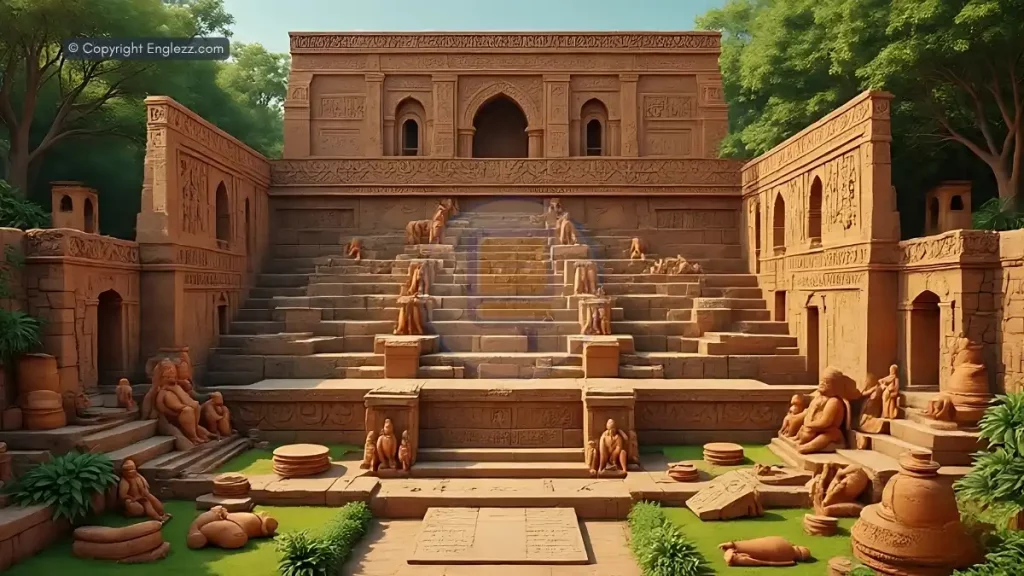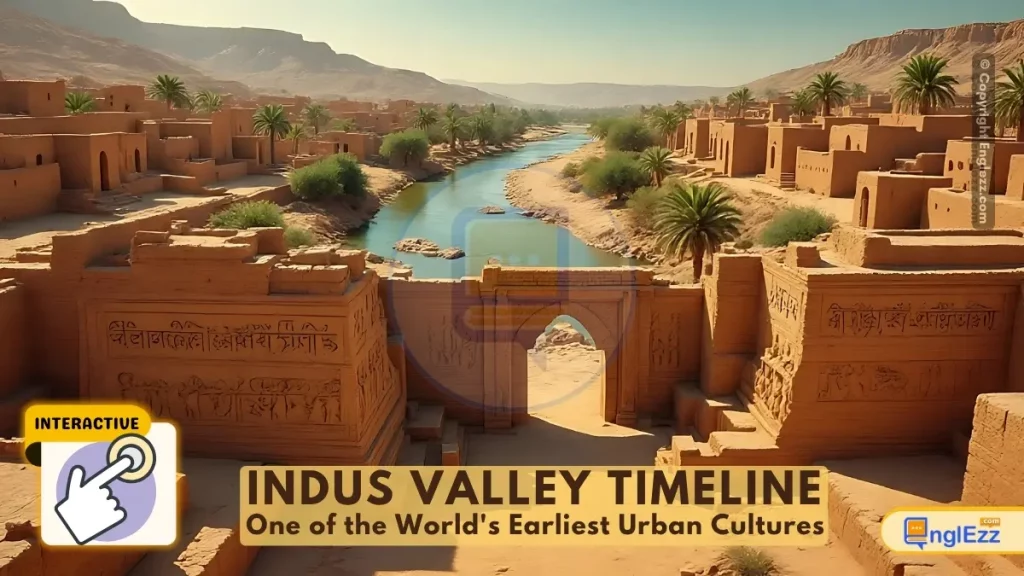
The Indus Valley Civilization
One of the World’s Earliest Urban Cultures (c. 3300 BCE – 1300 BCE)
Introduction
The Cradle of Ancient Urbanism
The Indus Valley Civilization, also known as the Harappan Civilization, was one of the world’s earliest urban cultures, flourishing around the Indus River basin in what is now Pakistan and northwest India from approximately 3300 BCE to 1300 BCE. This sophisticated Bronze Age civilization was contemporary with ancient Egypt and Mesopotamia, and at its peak, may have had a population of over five million people.
The civilization is noted for its advanced urban planning, baked brick houses, elaborate drainage systems, water supply systems, and clusters of large non-residential buildings. Indus Valley cities were remarkably uniform in their layout, suggesting a highly organized central authority. The civilization also developed new techniques in metallurgy (copper, bronze, lead, and tin) and produced intricate handicrafts, including beautiful seals that may have been used for trade.
This timeline explores the rise, flourishing, and eventual decline of this remarkable ancient civilization, highlighting its technological achievements, cultural developments, and enduring mysteries.
Early Harappan Phase
(3300-2600 BCE) The formative period of the Indus Valley Civilization saw the development of early farming communities that gradually evolved into larger settlements. During this phase, we see the emergence of pottery, early forms of writing, and the beginnings of trade networks that would later characterize the civilization.
Mature Harappan Phase
(2600-1900 BCE) The golden age of the civilization saw the development of major urban centers like Mohenjo-Daro and Harappa, with sophisticated city planning, standardized weights and measures, extensive trade networks, and the full development of the Indus script. This period represents one of the high points of ancient urban development.
Late Harappan Phase
(1900-1300 BCE) The civilization gradually declined, with urban centers being abandoned and populations shifting to smaller settlements. The reasons for this decline remain debated but may include climate change, river course changes, and the possible arrival of new populations. Despite the decline, many cultural elements persisted in later South Asian cultures.
Explore the interactive Indus Valley Civilization timeline below to discover key events and developments. Test your knowledge with our quiz when you’re ready!
Indus Valley Civilization Timeline
Emergence of Early Harappan Culture
The first villages appear in the Indus Valley, marking the beginning of the Early Harappan phase with early agricultural settlements and pottery traditions.
Read moreAround 3300 BCE, the first villages of what would become the Indus Valley Civilization began to appear in the floodplains of the Indus River and its tributaries. These early settlements, such as those at Mehrgarh in present-day Pakistan, represented the transition from nomadic hunter-gatherer lifestyles to settled agricultural communities.
Key developments of this period included:
- Domestication of wheat, barley, and cotton
- Early forms of irrigation to support agriculture
- Development of pottery-making techniques
- Emergence of trade networks for materials like lapis lazuli
- Early forms of the Indus script appearing on pottery
These early farming communities laid the foundation for the urban civilization that would follow, with increasing social complexity and technological innovation throughout the Early Harappan period.
Further Reading
- Possehl, Gregory L. The Indus Civilization: A Contemporary Perspective (2002)
- Kenoyer, Jonathan Mark. Ancient Cities of the Indus Valley Civilization (1998)
Development of Early Urban Centers
Settlements grow larger and more complex, with evidence of craft specialization and increased trade, foreshadowing the urban planning of the Mature Harappan phase.
Read moreBy around 2800 BCE, some Early Harappan settlements had grown into substantial towns, showing signs of the urban planning that would characterize the later Mature Harappan phase. Sites like Kot Diji and Amri show evidence of defensive walls, planned streets, and specialized craft production areas.
Key developments during this period included:
- Emergence of standardized brick sizes (a hallmark of later Harappan cities)
- Development of early water management systems
- Increased specialization in crafts like bead-making and metallurgy
- Expansion of trade networks to distant regions
- Further development of the Indus script
This transitional period represents the gradual evolution from village-based societies to the sophisticated urban civilization that would emerge in the Mature Harappan phase. The cultural continuity between Early and Mature Harappan periods suggests an indigenous development rather than outside influence.
Further Reading
- Wright, Rita P. The Ancient Indus: Urbanism, Economy, and Society (2010)
- McIntosh, Jane. The Ancient Indus Valley: New Perspectives (2008)
Mature Harappan Phase Begins
The full urban civilization emerges with large, planned cities like Mohenjo-Daro and Harappa, sophisticated water systems, and standardized weights and measures.
Read moreAround 2600 BCE, the Indus Valley Civilization entered its Mature Harappan phase, characterized by the emergence of large, well-planned urban centers. The two largest cities, Mohenjo-Daro and Harappa (from which we get the name “Harappan Civilization”), may have each housed up to 40,000-50,000 people at their peak.
Key features of Mature Harappan cities included:
- Grid-pattern street layouts with orientation to cardinal directions
- Sophisticated drainage and water supply systems
- Standardized brick sizes (4:2:1 ratio) throughout the civilization
- Large public structures like the Great Bath at Mohenjo-Daro
- Extensive trade networks reaching Mesopotamia and Central Asia
- Advanced metallurgy and craft production
The civilization covered about 1 million square kilometers at its peak, making it the most extensive of the ancient civilizations. Despite its size, there was remarkable uniformity in artifacts, city planning, and technology across the region, suggesting strong cultural integration.
Further Reading
- Kenoyer, Jonathan Mark. Ancient Cities of the Indus Valley Civilization (1998)
- Possehl, Gregory L. The Indus Civilization: A Contemporary Perspective (2002)
Peak of Indus Valley Civilization
The civilization reaches its zenith with over 1,000 settlements spread across the Indus River basin, extensive trade networks, and advanced urban infrastructure.
Read moreBy 2500 BCE, the Indus Valley Civilization had reached its peak, with a network of over 1,000 settlements spread across what is now Pakistan and northwest India. The civilization’s influence extended from the Himalayan foothills in the north to the Arabian Sea in the south, and from eastern Iran in the west to the Ganges-Yamuna doab in the east.
Characteristics of this peak period included:
- Five major urban centers (Mohenjo-Daro, Harappa, Dholavira, Ganeriwala, and Rakhigarhi)
- Standardized weights and measures used throughout the civilization
- Extensive maritime and overland trade with Mesopotamia (ancient Sumer)
- Advanced metallurgy producing bronze, copper, and lead artifacts
- Sophisticated craft production of beads, pottery, and seals
- Development of the still-undeciphered Indus script
The civilization’s trade networks were particularly impressive, with Harappan seals and artifacts found in Mesopotamian cities, and Mesopotamian texts mentioning trade with “Meluhha,” believed to be the Indus region.
Further Reading
- Ratnagar, Shereen. Trading Encounters: From the Euphrates to the Indus in the Bronze Age (2004)
- Parpola, Asko. The Roots of Hinduism: The Early Aryans and the Indus Civilization (2015)
Signs of Decline Begin
Evidence suggests the beginning of urban decline, with some cities showing signs of neglect and reduced maintenance of public infrastructure.
Read moreAround 2000 BCE, archaeologists begin to see signs of decline in the Indus Valley Civilization. While the civilization was still functioning, there is evidence of reduced maintenance of public works, less uniformity in artifacts, and some urban areas being abandoned or repurposed.
Possible indicators of decline include:
- Reduced maintenance of drainage systems and public buildings
- Decline in the quality and standardization of pottery and crafts
- Evidence of overcrowding in some urban areas
- Changes in burial practices and material culture
- Shifts in settlement patterns away from some urban centers
The reasons for this decline remain debated among scholars. Possible factors include:
- Climate change leading to reduced monsoon rains and river flow
- Changes in the course of the Indus River and its tributaries
- Deforestation and overuse of resources
- Possible earthquakes or other natural disasters
- Shifts in trade patterns that reduced economic vitality
Whatever the causes, this period marks the transition from the Mature Harappan to the Late Harappan phase.
Further Reading
- Giosan, Liviu, et al. “Fluvial landscapes of the Harappan civilization.” Proceedings of the National Academy of Sciences (2012)
- Possehl, Gregory L. The Indus Civilization: A Contemporary Perspective (2002)
Late Harappan Phase Begins
Major urban centers are largely abandoned, and the population shifts to smaller settlements with less sophisticated infrastructure, marking the start of the Late Harappan phase.
Read moreBy 1900 BCE, the major urban centers of the Indus Valley Civilization were largely abandoned, and the population shifted to smaller settlements. This marks the beginning of the Late Harappan phase (1900-1300 BCE), characterized by:
- Abandonment or significant reduction of major urban centers
- Shift to smaller, rural settlements
- Decline in long-distance trade networks
- Less uniformity in material culture and artifacts
- Simplification of craft production techniques
- Gradual disappearance of the Indus script
Despite these changes, many aspects of Harappan culture persisted, including:
- Continuity in some pottery styles and decorative motifs
- Ongoing use of some Harappan technologies
- Possible continuity in religious and cultural practices
- Gradual transformation rather than sudden collapse
The Late Harappan phase represents a period of cultural transformation rather than complete disappearance, with many elements of Harappan culture influencing subsequent cultures in the region.
Further Reading
- Shaffer, Jim G. “The Indus Valley, Baluchistan and Helmand Traditions: Neolithic Through Bronze Age.” Chronologies in Old World Archaeology (1992)
- Possehl, Gregory L. Indus Age: The Beginnings (1999)
End of Indus Valley Civilization
The last vestiges of Harappan culture disappear, though some cultural elements persist in later South Asian cultures.
Read moreBy around 1300 BCE, the last recognizable elements of the Indus Valley Civilization had disappeared. The reasons for the civilization’s ultimate demise remain debated, but likely involved a combination of factors:
- Climate change leading to reduced water availability
- Changes in river courses that disrupted agriculture and trade
- Possible migrations of new populations into the region
- Economic decline due to breakdown of trade networks
- Possible epidemic diseases
Despite the civilization’s disappearance, many aspects of Harappan culture may have influenced later South Asian cultures:
- Possible continuity in some religious symbols and practices
- Influence on later urban planning and water management
- Continuation of some craft traditions
- Possible linguistic influences (though this remains debated)
The civilization was largely forgotten until archaeological excavations in the 1920s revealed its impressive achievements. Today, the Indus Valley Civilization is recognized as one of the world’s earliest urban cultures and a remarkable example of ancient technological and organizational sophistication.
Further Reading
- Possehl, Gregory L. The Indus Civilization: A Contemporary Perspective (2002)
- McIntosh, Jane. The Ancient Indus Valley: New Perspectives (2008)
Indus Valley Civilization Quiz
Test Your Knowledge of the Ancient Indus Valley
Frequently Asked Questions
Common Questions About the Indus Valley Civilization
The urban planning of Indus Valley cities was remarkably advanced for their time and included several unique features:
- Grid-pattern layouts: Streets were laid out in precise grid patterns, often oriented to the cardinal directions.
- Standardized brick sizes: Bricks were made in a consistent 4:2:1 ratio throughout the civilization.
- Advanced drainage systems: Cities had covered drains running along streets, with inspection holes and sedimentation traps.
- Water supply systems: Many houses had their own wells, and public wells were strategically placed throughout cities.
- Uniformity across cities: Despite being spread over a vast area, cities shared similar layouts and construction techniques.
- Citadels: Many cities had elevated citadel areas that may have served administrative or religious purposes.
This level of urban planning was unmatched by other contemporary civilizations and suggests a highly organized central authority.
The Indus script remains undeciphered for several reasons:
- Short inscriptions: Most examples of the script are very short (average 5 signs), making patterns hard to discern.
- No bilingual texts: Unlike Egyptian hieroglyphs (deciphered using the Rosetta Stone), no bilingual inscriptions have been found.
- Unknown language: We don’t know what language the Harappans spoke, making it difficult to connect signs to sounds or meanings.
- Limited corpus: Only about 4,000 inscribed objects have been found, with about 400 distinct signs.
- Lack of archaeological context: Many inscriptions were found out of context or in early excavations with poor recording.
Despite these challenges, scholars continue to work on decipherment, using computer analysis and comparisons with other ancient scripts.
Our understanding of Harappan religion is limited but includes these elements:
- Possible mother goddess: Many small terracotta female figurines have been found, possibly representing a fertility goddess.
- Proto-Shiva figure: A seal showing a cross-legged figure surrounded by animals has been compared to later Hindu depictions of Shiva.
- Sacred trees and animals: Seals depict what may be sacred trees and animals like bulls and unicorns.
- Ritual bathing: The Great Bath at Mohenjo-Daro suggests ritual purification was important.
- Fire altars: Some sites have what appear to be fire altars, possibly for sacrifices.
- Burial practices: Both burial and cremation were practiced, with grave goods suggesting belief in an afterlife.
Some scholars see continuities between Harappan religious symbols and later Hindu traditions, though this remains debated.
The decline of the Indus Valley Civilization was likely caused by multiple factors:
- Climate change: Evidence suggests the monsoon weakened around 1900 BCE, reducing water availability.
- River course changes: The Ghaggar-Hakra river system dried up, disrupting agriculture and trade.
- Environmental degradation: Possible deforestation and overuse of resources may have contributed.
- Economic factors: Breakdown of trade networks with Mesopotamia reduced prosperity.
- Social/political factors: Possible internal unrest or failure of governing systems.
- Disease: Crowded urban conditions may have led to epidemics.
Earlier theories about an Aryan invasion causing the collapse have been largely discredited by archaeological evidence showing a gradual decline rather than sudden destruction.
Conclusion
The Legacy of the Indus Valley Civilization
The Indus Valley Civilization represents one of humanity’s earliest experiments with urban living and complex social organization. For nearly two millennia, this remarkable culture flourished, developing sophisticated technologies, extensive trade networks, and impressive urban centers that rivaled those of ancient Egypt and Mesopotamia.
Despite its eventual decline, the civilization left an enduring legacy. Many aspects of Harappan material culture and possibly religious symbolism may have influenced later South Asian traditions. The civilization’s achievements in urban planning, water management, and standardized systems continue to impress modern observers and provide valuable lessons about sustainable urban development.
Indus Valley Civilization Key Takeaways
Early Foundations
The Early Harappan phase (3300-2600 BCE) saw the development of agricultural communities that gradually evolved into urban centers, establishing cultural and technological foundations.
Urban Sophistication
The Mature Harappan phase (2600-1900 BCE) represents one of the ancient world’s most impressive urban civilizations, with planned cities, advanced infrastructure, and extensive trade networks.
Cultural Transformation
The Late Harappan phase (1900-1300 BCE) saw the decline of urban centers but possible continuity of cultural elements into later South Asian traditions.
The study of the Indus Valley Civilization continues to evolve as new archaeological discoveries are made. Ongoing excavations and scientific analyses promise to reveal more about this fascinating ancient culture and its place in human history.
Recommended Reading About the Indus Valley Civilization
- Kenoyer, Jonathan Mark. Ancient Cities of the Indus Valley Civilization (1998)
- Possehl, Gregory L. The Indus Civilization: A Contemporary Perspective (2002)
- McIntosh, Jane. The Ancient Indus Valley: New Perspectives (2008)
- Wright, Rita P. The Ancient Indus: Urbanism, Economy, and Society (2010)
- Parpola, Asko. The Roots of Hinduism: The Early Aryans and the Indus Civilization (2015)










Interactive Indus Valley Civilization Timeline reveals secrets of one of the earliest urban cultures. Journey through history like never before!